Passengers 103 Fatalities 108 Date 10 December 2005 | Crew 7 Injuries (non-fatal) 2 Number of deaths 108 Survivor 2 | |
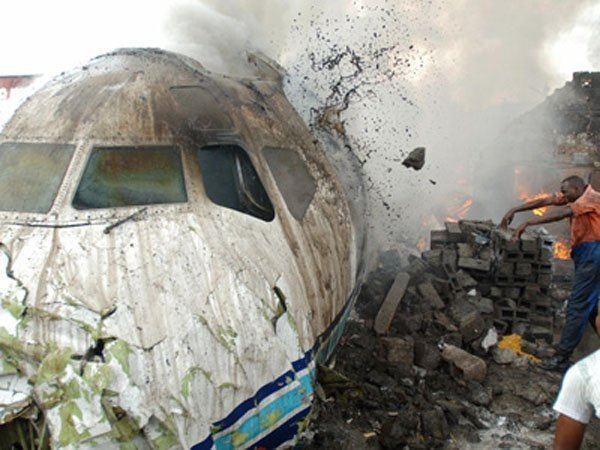 | ||
Summary Missed approach due to pilot error aggravated by windshear. Destinations Port Harcourt International Airport, Port Harcourt, Nigeria Similar Bellview Airlines Flight 210, Dana Air Flight 992, Kam Air Flight 904, Mandala Airlines Flight 91, West Caribbean Airways F | ||
Sosoliso Airlines Flight 1145 (SO1145/OSL1145) was a scheduled domestic passenger flight between the Nigerian cities of Abuja (ABV) and Port Harcourt (PHC). At about 14:08 local time (13:08 UTC) on 10 December 2005, Flight 1145 from Abuja crash-landed at Port Harcourt International Airport. The plane, a McDonnell Douglas DC-9-32 with 110 people on board slammed into the ground and burst into flames. Immediately after the crash, seven survivors were recovered and taken to hospitals, but it has since been reported that four of those survivors have died in hospital care, leaving three survivors, two of whom were flown to South Africa. In the end, two people survived.
Contents
- The flight
- Aircraft
- Passengers and crews
- Weather analysis
- Black Box analysis
- Eyewitness account
- Conclusion
- Legacy
- References
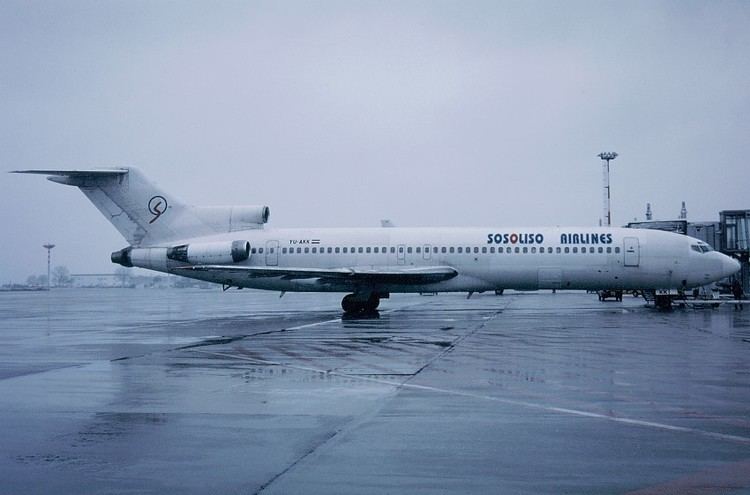
It was the second air disaster occurred in Nigeria in less than three months, after Bellview Airlines Flight 210 which crashed in 22 October 2005 with reason unknown, killing all 117 people on board. It was the company's first and only fatal accident.
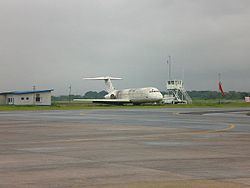
The flight
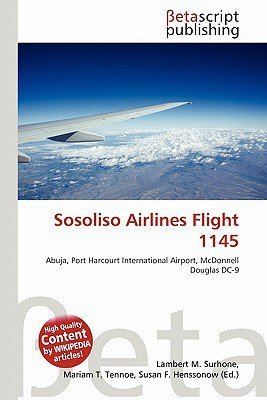
The aircraft departed Abuja's Nnamdi Azikiwe International Airport at 12:25 p.m UTC. The route would only take a total time of 2 hours and 40 minutes. About 90 miles from the airport, the aircraft contacted the airport for initial descent clearance and cleared by the tower to FL160. The aircraft continued its descent until 13:00, when the crews asked the tower about the weather condition in the airport. Control tower told the aircraft that rain didn't occur. However, scattered Cumulonimbus were present at the time. Later on, the crew acknowledged.
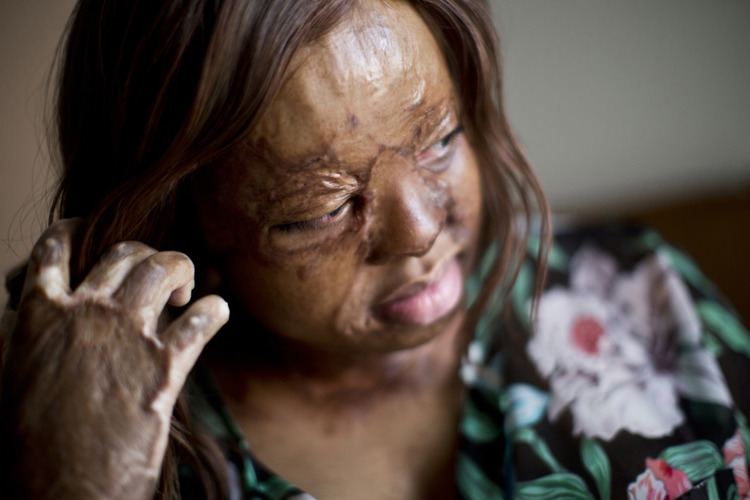
The aircraft then followed its glide path. ATC then contacted the aircraft that precipitation approaching the airport. The controller then cleared the aircraft to land at Runway 21, but warned the pilot that the runway could be slightly wet, indicating a hydroplaning could possibly occur. Flight crews acknowledged this message. Unable to make out the unlit runway through the rain, the captain called for a go around (missed approach) at an altitude of about 200 ft (approximately 120 ft above the ground). This call was made about 100 ft below the "decision altitude".
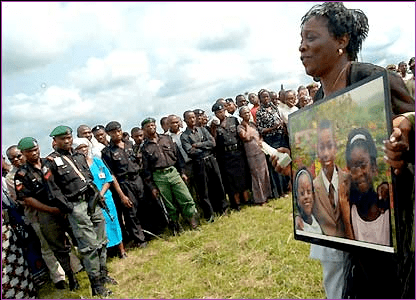
The DC-9 then slammed to a grass strip between the runway and the taxiway. 60 meter from the first impact point, the empennage struck a concrete drainage culvert. The aircraft disintegrated and burst into flames. The cockpit and the forward fuselage broke off from its main body and slid along the taxiway, creating a total trail of wreckage of 1.120 meter.
Aircraft
The McDonnell Douglas DC-9 was manufactured in 1973. It entered the Nigerian registration on 12 June 2003. It was owned by JAT Airways, and operated by Sosoliso Airlines Ltd. The aircraft certificate was released on 17 March 2005 and would have been due to another check on 27 June 2006. The aircraft was described as airworthy at the time of the accident.
Passengers and crews
The captain was Benjamin Adekunle Adebayo, a 48 year old Nigerian with a total flying experience of 10.050 hours with 1.900 of them were on the DC-9. He had his last simulator training at Pan Am International Flight Academy in Miami on 7 July 2005. The first officer was Gerad Yakubu Andan, a 33 year old Ghanaian with a total flying experience of 920 hours which 670 hours were on the type.He had his last simulator training on August 2005 with a result of 'satisfying'.
All seven crew members and 101 of the 103 passengers died in the crash, or later from their injuries. The two surviving passengers were seriously injured. Many passengers survived the initial impact and died in the resulting fire. Port Harcourt Airport had one fire truck and no ambulances.
Among the passengers were about sixty-one secondary school students from Loyola Jesuit College in the Federal Capital Territory region of Nigeria. At first Loyola Jesuit College students from Port Harcourt traveled between school and their homes via buses using the roads. Rising crime along roads during the 1990s made parents believe that road travel was too dangerous. In 2001, when Sosoliso Airlines began services between Port Harcourt and Abuja parents placed their children on the flights.
Among the victims were two volunteers for Medecins Sans Frontieres/Doctors Without Borders en route to work in Port Harcourt, Hawah Kamara and Thomas Lamy, as well as televangelist Bimbo Odukoya, pastor of the Fountain of Life Church, who succumbed to her injuries the day after the accident.
One survivor, Kechi Okwuchi, was treated in Milpark Hospital at Johannesburg, South Africa as of 14 December 2005 and at Shriners Hospitals for Children in Galveston, Texas, United States as of 6 September 2007.
Weather analysis
The Nigerian Accident Investigation Bureau found out that the data from satellite imagery by Boeing Aircraft Company in USA suggested that at 13:00 UTC, a sea breeze front, possibly reinforced by an outflow, pushed inland in the vicinity of Port Harcourt. The leading edge of the boundary, in theory, could have included an abrupt increase in wind speed and significant horizontal and/or vertical windshear. Rain showers and thunderstorm was also likely occurred as warm and moist air were lifted into the atmosphere.
Data from Nigerian Meteorological Agency showed that there was a change in the wind speed and direction as the aircraft approaching the airport. The weather was deteriorating fast, and visibility was limited heavily. The change of wind speed and direction created a perfect ingredient for wind-shear occurring in the airport.
Black Box analysis
As the Flight Data Recorder and the Cockpit Voice Recorder were retrieved by investigators, it has been revealed that both black boxes had been damaged. The FDR had a slight damage, and were downloaded by investigators in a file. However, the situation is different for the CVR. The CVR coaxial spools were under tension during its normal operating flight. When the tape was severed, the spool could have spun freely which resulted in the release of additional tape into the transport area. There were some problems with both black boxes, but later the data was filtered for several times until the audio became reasonably intelligible.
From the FDR data, it was revealed that the flight was uneventful until its final approach. 30 seconds before the crash, the aircraft descended for 7 seconds and leveled off at an altitude of 204 ft, which is below the Decision Altitude of 307 ft. The airspeed then decreased to 145 knots. Few seconds later, there was an increase of speed to 151 knots, indicating that flight crews called for a go-around and initiate it. However, the aircraft had sunk well below 204 ft and headed to the left. The crew were unable to recover the plane, and the data ceased functioning when the aircraft speed was at 160 knots.
From the CVR data, 16 seconds before the crash, the Captain called for a go-around, gear up and flaps before the crash. A warning horn then appeared followed by a 'too low gear' aural sound. Apparently, the pilots had difficulty in sighting the runway and should have carried a missed approach on the Decision Altitude of 307 ft instead of continuing descent below 204 ft. The flaps were retracted and the gear was extended. But probably, the gear wasn't locked. The 'too low gear' warning then appeared again, and a Ground Proximity Warning System followed.
Eyewitness account
Investigators conducted an interview with an eyewitness of the crash. The eyewitness was a Nigerian Airspace Management Agency(NAMA) security guard stationed about 1 km from the runway. He stated that the condition at the airport was dark and light precipitation were present. He saw the aircraft coming and stated that the aircraft was not stable as it passed over him. He further stated that the approach lights were not on and everywhere was dark and raining. Seconds later, he heard a loud bang, with fire and thick smoke. Another eyewitness, a Sosoliso Airlines pilot departed to Enugu also stated adverse weather condition in the airport. Firemen in the airport handling the crash were also stated bad weather condition were present, as they were forced to reposition their equipments due to high wind. This implies that the crew wasn't prepared to execute a missed approach at the decision altitude as the aircraft descended below the decision altitude. Apparently, the crews didn't follow the right procedure for a missed approach. Even if they conducted a recovery from adverse weather associated with windshear, the procedure adopted by the crew were improper.
Conclusion
Nigeria Accident Investigation Bureau finally concluded that the probable cause of the crash was due to the crew's decision to continue the approach beyond the Decision Altitude without having the runway insight. The adverse weather condition, were listed as contributing factors.
Legacy
Andy and Ify Ilabor, the parents of crash victims Chuka, Nkem, and Busonma "Buso" Ilabor, started a foundation called the Ilabor Angels to assist orphans and AIDS victims.
Loyola Jesuit dedicated a Memorial Hall to the deceased students.
The International Civil Aviation Organization (ICAO) mandates that each family of an air crash victim is entitled to only 3 million naira or US$18,157 from the airline. In January 2009 Harold Demuren, the director general of the Nigerian Civil Aviation Authority (NCAA), said that the families of the air crash victims would be compensated and that Sosoliso had already paid $2.3 million into an escrow account to compensate the families.
